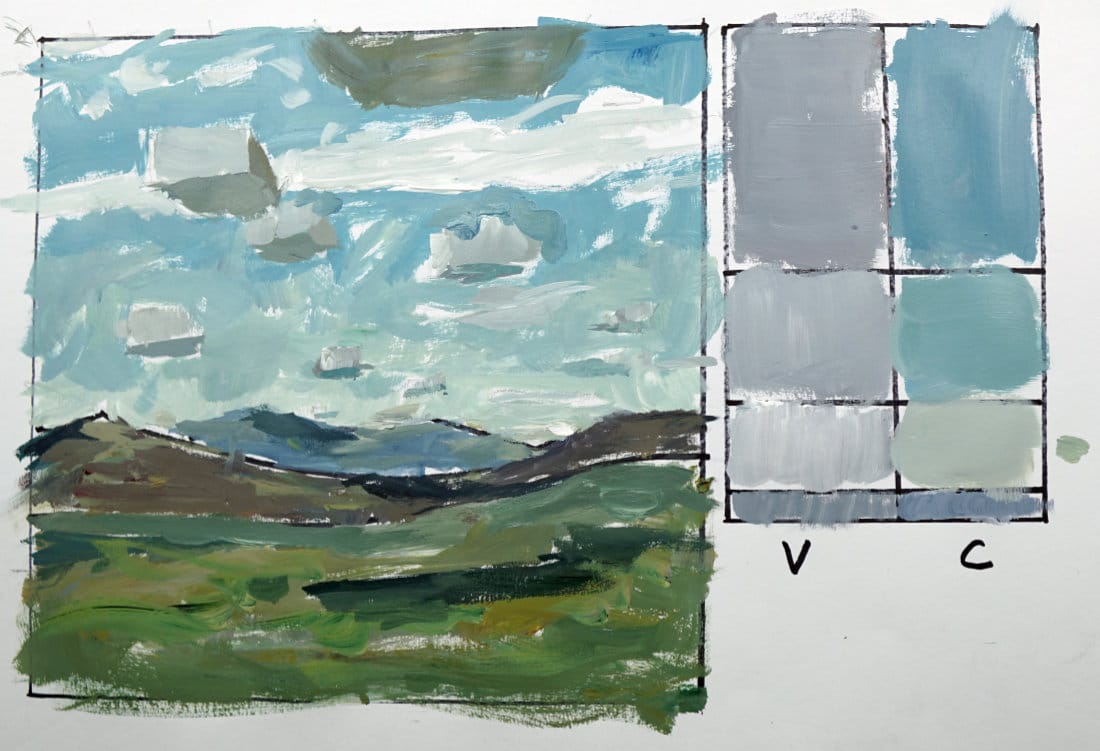Sky and Cloud Assignment – Instructor Demo Example
See the completed version of the Sky and Cloud Assignment. Use this acrylic landscape demo as a visual guide to compare your own painting study.

This post shows my completed version of the Sky and Cloud Assignment from the Acrylic Landscape Painting Fundamentals Course.
Use this demo as a visual reference for how all the concepts—linear perspective, gradations, cloud structure, and ground planes—come together in a single piece.
Planning the Sky and Perspective
I start the piece by laying in linear perspective lines for the clouds. The goal is to have each cloud’s “belly” or underside follow the same vanishing point direction. Closer clouds are larger with wider undersides, while distant ones get smaller and tighter as they move toward the horizon.
Once those shapes are set, I begin sketching small overlapping cumulus forms to vary scale and direction.

Adding Light, Shadow, and Gradation
With perspective in place, I block in shadow patterns based on a single light source. These help anchor the clouds into the landscape. Some of the shadows stretch across the mountains or distant hills to connect the sky with the ground.
Before moving to color, I create a value gradation chart as a reference—starting with my lightest sky values and working darker toward the top. This keeps my overall atmosphere consistent across the painting.
Mixing and Building the Sky
The sky begins with a smooth gradation from warm ochres and pale yellows near the horizon to cooler blue and violet tones higher up. I use Viridian, Ultramarine, and touches of Alizarin Crimson to adjust value and temperature.
The goal isn’t to create bands of color but to keep transitions soft and natural, suggesting distance and open air.
Forming Clouds and Ground Planes
Each cloud is developed with box-like thinking—flat bottoms, rounded tops, and side planes that respond to light direction. Warm, lighter hues face the sun while cooler grays sit underneath. I glaze the distant mountains in muted blues and violets, then add warmer ochres and greens to the foreground for balance.
The ground plane follows the same logic: cooler tones recede, warmer tones advance. Subtle cloud shadows on the landscape tie everything together and create cohesion between sky and land.
Wrapping Up
The final painting brings together perspective, value gradation, and atmospheric layering. Remember, this demo isn’t about perfection—it’s about clarity. Once your study is complete, compare it with mine and note how your choices of hue, shadow, and shape affect the mood of your scene.
Course Navigation
Next Lesson: Atmospheric Conditions Module - coming soon
Previous Lesson: Sky and Cloud Assignment
Landscape Hub: View All Acrylic Landscape Lessons
Learn & Improve Your Acrylic Skills
- Acrylic Hub– Your go-to guide for tutorials, tips, and resources.
- Ultimate Beginner Acrylic Course - Start painting with confidence.
- Subscribe for More Great Content - Get tutorials, tips, and updates straight to your inbox.
- Follow Me on Pinterest - Daily inspiration, tips, and fresh ideas.
Recommended Acrylic Painting Materials
-
Princeton Catalyst Brushes – Flats (#6, #12), Rounds (#4, #8), Fan (#4), Liner Brush
Durable synthetic bristles for versatile acrylic techniques -
Liquitex Heavy Body Acrylic Paint – Essential Colors
Cadmium Yellow, Yellow Ochre, Alizarin Crimson, Cadmium Red Light, Ultramarine Blue, Cobalt Blue, Burnt Sienna, Titanium White -
Winsor & Newton Cotton Canvas
Reliable stretched canvas for studio and plein air work -
Strathmore 400 Series Mixed Media Paper
Heavyweight, acid-free paper for acrylic and mixed media -
Fabriano Artistico 140lb Cold Press Paper
Excellent for acrylic, mixed media, and textured effects -
Blick Multi-Colored Painting Knife Set
Variety of shapes for texture, scraping, and bold strokes - Miscellaneous: Two pint-sized water containers, paper towels (from Home Depot or Walmart)
- Note: I use canvas or sturdy cardboard as my palette — no store-bought palettes needed.




